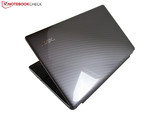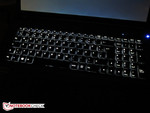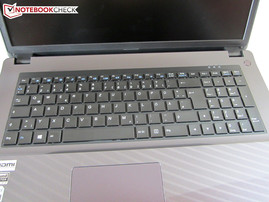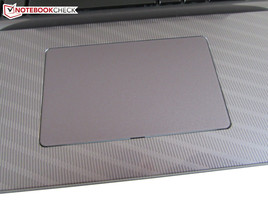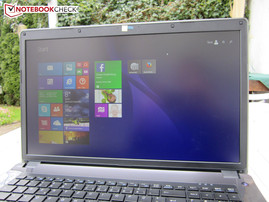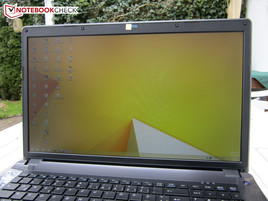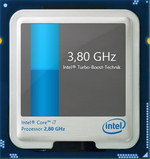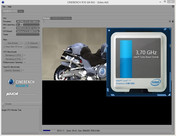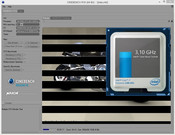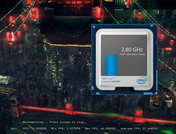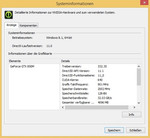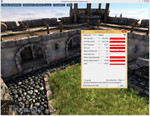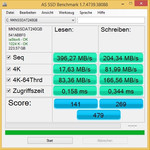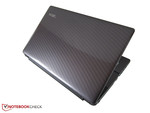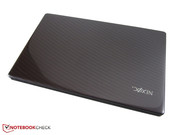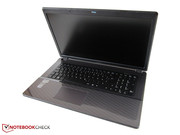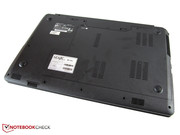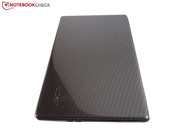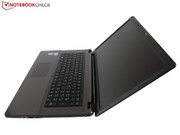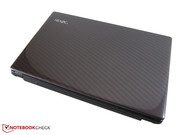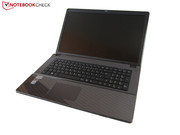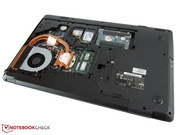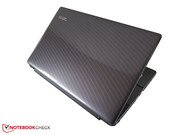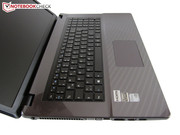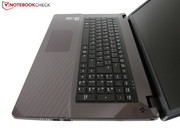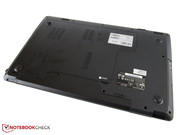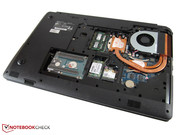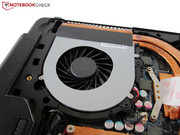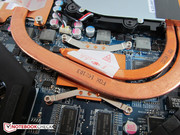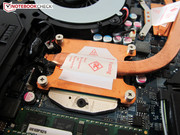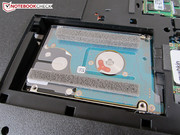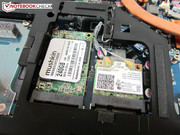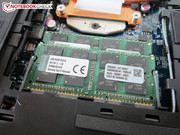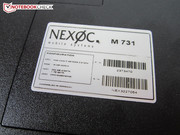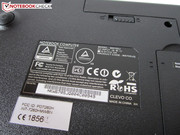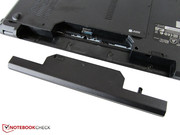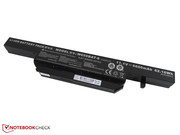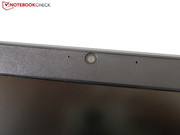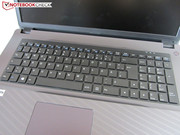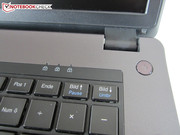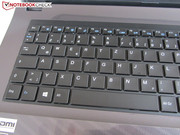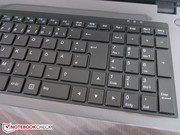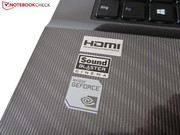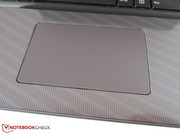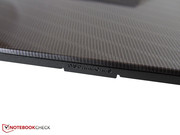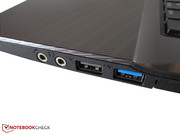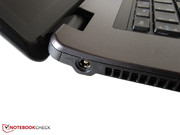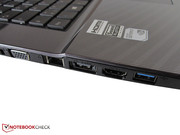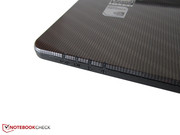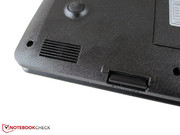Review Clevo W670SJQ (Nexoc M731) Barebones Notebook
For the original German review, see here.
Nvidia's latest GPU generation does not only result in updated notebooks, but also a redesign of Nexoc's homepage. Instead of boring text elements on a black background, the customer can now expect a stylish design.
The situation is similar for the case of the M731: Instead of dark dreariness, which is similar to many rivals, we can find a silver-gray pattern that covers the lid and the palm rest.
You can also configure your device individually. You should definitely upgrade the base configuration for 618 Euros if you want to be well-suited for the upcoming years. An Intel Pentium 3550M, four GB DDR3-RAM, a 500 GB HDD and a GeForce 840M are not bad by any means, but we would definitely recommend a GeForce GTX 850M, eight GB memory, an (mSATA) SSD and a processor from the Core i5 or Core i7-series.
Optical drive is either a DVD or a Blu-ray burner. Furthermore, you can choose between three wireless adaptors, several operating systems (Windows 7 or 8) and optional peripherals.
Our review unit is currently available for little more than 1,500 Euros (as of April 2014), you can see the specifications on the right side.
Case
The Taiwanese gaming expert Clevo was pretty adventuresome with its W670SJQ barebone in terms of design (the construction follows a more classic design). Even though the plastic surfaces have a glossy finish, they do not really attract a lot of dirt. At least subjectively, you can only see the fingerprints at a closer inspection.
Compared to the more powerful W370SS barebone (Nexoc G728II with GTX 860M), the W670SJQ is around 8 millimeters thinner, but weighs pretty much the same. Almost 3.1 kilograms are neither very heavy nor very light for a gaming device. If you prefer a compact chassis, you should either get the MS-1771 chassis from MSI (GS70, Schenker XMG C703, Medion Erazer X7611) or a smaller notebook. The 15-inch barebone sibling W650SJ (Schenker M504) only weighs around 2.5 kilograms.
The M731 is decent in regard to the stability. Except for the lid and the optical drive, which can be – typically for notebooks – pushed in or twisted, respectively, the chassis is pretty torsion-resistant. Clevo should definitely improve the hinges, despite the firm construction (you need both hands to open the lid), they cannot prevent display bouncing during vibrations.
Build quality and the quality of the materials are average. Nothing speaks against a purchase if you can live with some small issues (some gaps are not consistent). Nobler solutions would be the Asus N750 and HP Envy 17, for instance.
Connectivity
Ports
The port variety is not very spectacular. An analog and a digital video port (VGA + HDMI) are mandatory for a multimedia notebook, just like two stereo jacks, one RJ45 Gigabit-Ethernet port as well as an opening for a Kensington Lock. Furthermore you get a card reader, two USB 3.0 ports, one USB 2.0 port and one eSATA/USB 3.0 combination.
We do have to criticize the port layout. Most ports are very far at the front of the sides, so there can be problems with the space and annoying collisions when you use a mouse. The Nexoc G728II had a more sophisticated layout.
Wireless Communication
The wireless communication of our review unit is handled by the Wireless-N 7260 controller from Intel, which supports Bluetooth 4.0 as well as WLAN 802.11 a/b/g/n (no ac-support!) with maximum transfer rates of 300 Mbps. According to the manufacturer, you can use 2.4 and 5 GHz networks.
The wireless performance is decent in terms of range. Windows 8 still showed 1-3 bars in the office of the author, which is around 15 meters away from the router (several rooms/walls in between).
Maintenance
As usual for Clevo barebones, the maintainability of the W670SJQ is very comfortable. The bottom cover is just secured with two Philipps screws. It reveals an mSATA slot, one 2.5-inch bay, two memory slots and a wireless module. Most of the space is occupied by the cooling solution that consists of two heat pipes, a cooling unit and a fan. The graphics card is soldered onto the mainboard, while the processor can be replaced if necessary.
Software
Similar to the German notebook rivals Schenker and One, Nexoc does not install any bloat ware. The Windows installation is completely clean.
Scope of Delivery
The Bavarian manufacturer is also very restrained in terms of accessories. Quick start guide, driver DVD and Nero 12 Essentials: That's about it, although there is obviously also a battery (6 cells, 326 grams) and the power adaptor (120 Watts, 462 grams).
Warranty
Nexoc grants a warranty of two years, which can be extended to three years for an additional 65 Euros. A 72-hour service (12 months, +20 Euros) and a Pickup service (24 months, +25 Euros) are available as well.
Input Devices
Keyboard
Contrary to the W370SS barebone, the W670SJQ is equipped with an illuminated keyboard (two stages). The white background lighting is not very bright, but using the keyboard in dark environments is still no problem.
The chiclet keyboard also leaves a decent impression in the other categories. Thanks to the small spacing, the 15 x 15 millimeters large keys appear very clear. Clevo reduced the size of the 0 from the numeric keypad to include normal sized arrow keys. Otherwise the layout is pretty standard, which cannot be said about the other barebones (see P170SM or P177SM).
Great: As usual, you can control several features via Fn-combinations, for instance the touchpad, the display, the sound, the webcam or the wireless module. Typing experience and acoustics seem to be okay, although there is still room for improvement. All in all, the keyboard gets a good rating.
Touchpad
We are not really satisfied by the touchpad, or more precisely the clickpad. After so many negative examples (Lenovo Y510p, Clevo P370SM...) we are really not sure why this technology is so popular among notebook manufacturers.
The answer is difficult, because the mechanics of the Nexoc M731 is also pretty imprecise and prone to errors. The cursor seems to float above the surface instead of being controlled precisely. Clicks are also not recognized properly, which often requires a second or even a third input. This drawback cannot be compensated by the multitouch support (gesture support) and the smooth and convenient surface, which does however get very sticky with greasy or wet fingers.
Gamers on the other hand will be happy that the 105 x 65 millimeters large touchpad has been shifted towards the right and does not sit directly beneath the space bar.
Display
The 17.3-inch panel has the designation Chi Mei N173HGE. The big strength of the non-glare display is the enormous contrast. While other TN rivals only manage values between 400-700:1, the Chi Mei N173HGE reaches more than 900:1.
A brightness of more than 300 nits is also more than respectable. Combined with the anti-reflective display surface, the M731 is well-suited for outdoor environments (compare pictures below). Besides the brightness, we are also convinced by the black value: 0.34 cd/m² suggest a crisp presentation of darker gaming and movie passages.
| |||||||||||||||||||||||||
Brightness Distribution: 77 %
Center on Battery: 331 cd/m²
Contrast: 974:1 (Black: 0.34 cd/m²)
ΔE Color 11.57 | 0.5-29.43 Ø5
ΔE Greyscale 11.64 | 0.57-98 Ø5.3
54% AdobeRGB 1998 (Argyll 1.6.3 3D)
61.7% AdobeRGB 1998 (Argyll 2.2.0 3D)
84.3% sRGB (Argyll 2.2.0 3D)
61.6% Display P3 (Argyll 2.2.0 3D)
Gamma: 2.74
However, the performance is not completely perfect. For starters, we would have wanted a better brightness distribution. 77 percent leave room for improvement, especially since we can determine – similar to many panels – some screen bleeding at the peripheral zones of the display. Another point of criticism is the surface structure. Chi Mei's N173HGE struggles with a grainy finish for a couple of years now, which might be annoying for some users.
The viewing angle stability gets a better rating. You should not tilt the display too far backwards or forwards, horizontal viewing angles on the other hand are much better. But viewing angles or not: We think it is a pity that the 17.3-inch device cannot be equipped with an IPS panel. The W650SJ barebone creates – despite the smaller color space – a more coherent picture.
Performance
Processor
Processor is either a dual-core or quad-core model from Intel's Haswell generation. Although a dual-core from the i5-series would be sufficient for the GeForce GTX 850M (more on that later), Nexoc decided to equip our review unit with a powerful high-end CPU.
Considering the six MB L3 cache and the clock of 2.8-3.8 GHz, the Core i7-4810MQ is one of the most powerful CPUs in general. Similar to its smaller (and usually significantly less expensive) siblings, the 4810MQ is manufactured in 22 nm. The TDP is specified with 47 Watts, which is around 30 percent above the dual-core versions.
Another important component is the integrated graphics card. The HD Graphics 4600 is not really fast compared to the GTX 850M, but it helps improving the power consumption with simple tasks like office, video playback or web browsing. Clevo included the support for switchable graphics for this purpose.
Turbo Boost
One reason why we would not recommend the most expensive CPUs, is the limited Turbo Boost. Instead of up to 3.8 GHz (single-core load) and up to 3.6 GHz (multi-core load), the Core i7-4810MQ only manages 2.8-3.7 and 2.8-3.1 GHz, respectively.
Cinebench R10, that we used for our Turbo measurements, showed a pretty fluctuating clock in general. Other benchmarks showed this suboptimal behavior as well. We also determined a slight throttling (2.7 vs. 2.8 GHz) with short drops to 1.9 GHz.
CPU Performance
You can hardly notice the fluctuating Turbo in the single-core tests. 148 points of the 22 nm model in Cinebench R15 are around 13 % ahead of a Core i7-4700MQ (131 points @Schenker XMG A504) and 16 % ahead of a Core i5-4310M (128 points @Schenker M504). The 100 MHz slower Core i7-4800MQ falls behind as well (143 points @One K73-4N).
The results of the Multi-CPU test are not as overwhelming: 627 points are closer to the 4700MQ (600 points) than the 4800MQ (663 points). However, the luxury chip is clearly ahead of the 2.7-3.4 GHz Core i5-4310M (325 points); an advantage of almost 90 % is impressive.
| Cinebench R15 | |
| CPU Single 64Bit (sort by value) | |
| Core i7-4810MQ | |
| Core i7-4800MQ | |
| Core i7-4700MQ | |
| Core i5-4310M | |
| CPU Multi 64Bit (sort by value) | |
| Core i7-4810MQ | |
| Core i7-4800MQ | |
| Core i7-4700MQ | |
| Core i5-4310M | |
| Cinebench R11.5 | |
| CPU Single 64Bit (sort by value) | |
| Core i7-4810MQ | |
| Core i7-4800MQ | |
| Core i7-4700MQ | |
| Core i5-4310M | |
| CPU Multi 64Bit (sort by value) | |
| Core i7-4810MQ | |
| Core i7-4800MQ | |
| Core i7-4700MQ | |
| Core i5-4310M | |
Graphics
The GeForce GTX 850M is based on Nvidia's brand-new Maxwell architecture. 640 Unified Shader are similar to the GTX 860M, but Nvidia reduced the clock.
The big performance difference is mainly caused by the memory type. The GTX 850M usually only has DDR3 instead of GDDR5 video memory, which, in combination with the small interface (128-bit), can result in performance limitations. The amount of memory itself is sufficient; 2,048 MB should be enough for a while.
Although some specifications remind us of the predecessor, the GeForce GTX 850M does not have a lot in common with the GT 750M. Main difference is the significantly higher number of shaders. Nvidia equips the GTX 850M with around two thirds more CUDA cores (hardly comparable because of the new architecture). The manufacturing process on the other hand did not change: 28 nm are the current standard for graphics cards.
A few more words about the automatic overclocking: As you can see in the right screenshot and in the Temperature section, the GTX 850M always works with its maximum clock (the tool GPU-Z shows 1,084 MHz). We used the preloaded driver version 332.35.
GPU Performance
You can see that the GeForce GTX 850M is the transition between midrange and high-end performance when you look at the benchmarks. 3,062 points in the Fire Strike test of the current 3DMark are ahead of the GeForce GTX 765M (2,349 points @ Schenker XMG C703) as well as the DDR3 version of the GeForce GT 750M (1,573 points @ Asus N750JV). The Maxwell version of the GTX 860M on the other hand is almost 30 % faster (3,947 points) @Nexoc G728II).
Unigine Heaven 3.0 determines a decent result for the notebook as well. 41.8 fps with 1920x1080 pixels and normal tessellation are right between a GeForce GTX 765M (34.3 fps @Alienware 14) and a GeForce GTX 860M (49.6 fps @Schenker XMG P304). Especially impressive is the difference to the GT 750M (22.3 fps @One K56-3F): +87 % are a big improvement.
| 3DMark - 1920x1080 Fire Strike Graphics (sort by value) | |
| GeForce GTX 850M DDR3 (332.35) | |
| GeForce GTX 860M Maxwell (332.60) | |
| GeForce GT 750M DDR3 (311.54) | |
| GeForce GTX 765M (311.83) | |
| 3DMark 11 - 1280x720 Performance GPU (sort by value) | |
| GeForce GTX 850M DDR3 (332.35) | |
| GeForce GTX 860M Maxwell (332.60) | |
| GeForce GT 750M DDR3 (311.54) | |
| GeForce GTX 765M (311.83) | |
| 3DMark Vantage - 1280x1024 P GPU no PhysX (sort by value) | |
| GeForce GTX 850M DDR3 (332.35) | |
| GeForce GTX 860M Maxwell (332.60) | |
| GeForce GT 750M DDR3 (311.54) | |
| GeForce GTX 765M (311.83) | |
| 3DMark Vantage P Result | 15606 points | |
| 3DMark 11 Performance | 4659 points | |
| 3DMark Ice Storm Standard Score | 99736 points | |
| 3DMark Cloud Gate Standard Score | 13962 points | |
| 3DMark Fire Strike Score | 2801 points | |
Help | ||
Storage Devices
Similar to the Nexoc G728II, the M731 also has a combination of an mSATA SSD and a 2.5-inch hard drive. Let’s start with the solid state drive, which is once again provided by the company Mushkin.
Unfortunately, the Atlas MKNSSDAT240GB shows the same issues that we already determined in the review of the G728II. The performance varies a lot depending on the benchmark run. We suspected an hardware error in the case of the 17-inch sibling, but the SSD gets very hot even during light workloads (more than 60 °C according to CPUID HWMonitor and HDTune) and the status LED of the M731 is red as well, so we think the drive may suffer from insufficient cooling. Maybe Nexoc should change the SSD manufacturer.
To reduce the temperatures (keyword fan activity) and achieve the highest results, we stressed the CPU and the GPU before the final benchmarks. Almost 396 MB/s for sequential reading and 204 MB/s for sequential writing are still average at best. It is the similar situation with the access times: 0.158 and 0.344 ms, respectively, are clearly beaten by most rivals. AS SSD only determined an overall score of 479; good solid state drives manage at least 700 points.
Our review unit is also equipped with an SSHD, a hybrid drive. Thanks to the flash memory and the large capacity, the moderate speed (5,400 rpm) of the Seagate ST1000LM014 does not have such a big effect on the performance compared to conventional HDDs. Hybrid drives have to get used to the system before they achieve their maximum performance, which is also supported by CrystalDiskMark. The sequential read speed, for instance, jumped from 68 to 86 MB/s after three benchmark runs; the sequential writing performance on the other hand immediately climbed to 110 MB/s.
System Performance
The system performance is slightly higher than the Nexoc G728II, not least because of the faster processor. 6,007 points in PCMark 7 are excellent for a combination of all-rounder and gaming notebook. The M731 is on one level with other high-end laptops with this result, for example the Schenker XMG P724, One K73-4N or Gigabyte P34G. The score would be significantly lower without an SSD.
| PCMark 7 Score | 6007 points | |
| PCMark 8 Home Score Accelerated v2 | 3702 points | |
| PCMark 8 Creative Score Accelerated v2 | 5076 points | |
| PCMark 8 Work Score Accelerated v2 | 4461 points | |
Help | ||
Gaming Performance
The M731 handled our gaming benchmarks pretty well. The performance of the DirectX-11 chip is usually not sufficient for maximum details and 4x MSAA, but high settings and 2x Anti Aliasing are often smooth – even in the native resolution of 1920x1080 pixels (the »High« benchmarks were performed with 1366x768 pixels). We recommend a lower resolution for more demanding titles like Crysis 3, Hitman: Absolution or Call of Duty: Ghosts.
Our chart below the verdict shows that it does not really matter if you use the GeForce GTX 850M with a dual-core or a quad-core processor, and the subjective advantage or disadvantage, respectively, is very small if the frame rate should differ.
Overall, the DDR3 version of the GTX 850M is around 4 % faster than a GTX 765M and 80 % faster than its GT 750M counterpart. However, the M731 cannot keep up with GTX 860M notebooks; the Maxwell sibling has an advantage of up to 70 % in games (average: +36 %).
| low | med. | high | ultra | |
| Guild Wars 2 (2012) | 58.4 | 23.8 | ||
| Hitman: Absolution (2012) | 36.8 | 14.3 | ||
| Far Cry 3 (2012) | 48 | 16.1 | ||
| Crysis 3 (2013) | 34.8 | 13 | ||
| Tomb Raider (2013) | 65.1 | 31.6 | ||
| BioShock Infinite (2013) | 82.8 | 28.4 | ||
| Metro: Last Light (2013) | 43.2 | 21.7 | ||
| GRID 2 (2013) | 103.7 | 36.8 | ||
| Dota 2 (2013) | 68.4 | |||
| Saints Row IV (2013) | 36.7 | 23.1 | ||
| F1 2013 (2013) | 113 | 69 | ||
| Battlefield 4 (2013) | 56.4 | 20.7 | ||
| Call of Duty: Ghosts (2013) | 40.6 | 21 | ||
| X-Plane 10.25 (2013) | 25.2 | 17 | ||
| Thief (2014) | 37.6 | 18.1 | ||
| Titanfall (2014) | 56.7 | 32.9 | ||
| The Elder Scrolls Online (2014) | 65.3 | 33.7 |
Emissions
System Noise
A good fan control, which is restrained during Windows operation and not too loud under stress, is not very common amongst high-end devices. Especially Clevo barebones are notorious for very loud fans. We were excited to hear the results of the Nexoc M731.
While the 17-inch notebook is still comparatively quiet during idle (fan is spinning with 30-33 dB(A)), it gets really loud during 3D operation. 47 dB(A), which were constant during 3DMark 06, are clearly audible and annoying for some users. You can at least compensate the cooling with a headset or ambient noise.
Potential buyers will have to live with a pulsating fan in general, which is typical for Clevo barebones. The fan occasionally jumps to around 40 dB(A) without a reason.
Noise Level
| Idle |
| 30.1 / 30.8 / 33.4 dB(A) |
| HDD |
| 30.8 dB(A) |
| DVD |
| 35.3 / dB(A) |
| Load |
| 46.8 / 51.4 dB(A) |
 | ||
30 dB silent 40 dB(A) audible 50 dB(A) loud |
||
min: | ||
Temperature
Temperatures are decent for a gaming notebook. We can measure up to 49 °C at the left side of the case under maximum load, but an average result of 39 °C (top) and 35 °C (bottom), respectively, is reasonable.
The latter attribute also applies for idle operation. After an idle period of two hours, the notebook leveled off at around 31 °C. The M731 would have got a better rating if the palm rest was cooler (up to 40 °C).
A look at the components shows that the CPU is once again hot-headed. HWMonitor indicated around 90-95 °C during the stress test, despite the deactivated Turbo Boost. The GeForce GTX 850M only warmed up to 83 °C.
(-) The maximum temperature on the upper side is 49.1 °C / 120 F, compared to the average of 36.9 °C / 98 F, ranging from 21.1 to 71 °C for the class Multimedia.
(-) The bottom heats up to a maximum of 47.4 °C / 117 F, compared to the average of 39.1 °C / 102 F
(+) In idle usage, the average temperature for the upper side is 30.5 °C / 87 F, compared to the device average of 31.2 °C / 88 F.
(-) The palmrests and touchpad can get very hot to the touch with a maximum of 40.4 °C / 104.7 F.
(-) The average temperature of the palmrest area of similar devices was 28.8 °C / 83.8 F (-11.6 °C / -20.9 F).
Speakers
As usual for notebooks, the sound quality is not really overwhelming. It does not matter if you watch movies, play games or listen to music: The sound is pretty muffled and imprecise. One reason for that might be that Nexoc did not install the Sound Blaster Cinema software, which should be available, at least according to a sticker on the case.
However, no Clevo chassis offers a really convincing sound performance so far. Only the thicker 17-inch barebones P170SM, P177SM and P370SM sound somewhat decent. The maximum volume is sufficient, but other multimedia and gaming notebooks have better sound systems, for example the MSI GT70 or the Asus N750.
Energy Management
Power Consumption
The energy management of the W670SJQ cannot completely convince us. Main point of criticism is the high consumption when the battery is attached. Despite a full charge, the Nexoc M731 pulled around 5 Watts from the socked while it was turned off. Other models suffered from the same phenomenon; the device only consumed 0.1-1.2 Watts without the battery. 13-26 Watts during idle are also mediocre, and even some more powerful notebooks consume less (11-28 Watts @ MSI GT70).
Under load we can see a consumption similar to the GTX 860M. 83 Watts (3DMark 06) and 132 Watts (stress test) for the M731 are just sightly lower than the Schenker XMG P304, which consumed 91-135 Watts in our review configuration.
| Off / Standby | |
| Idle | |
| Load |
|
Battery Runtime
The gaming device is powered by a 6-cell battery with 62 Wh that provides reasonable but not very long battery runtimes. Around three hours DVD playback with the maximum display brightness should be sufficient for most movies.
The Reader’s test of Battery Eater, which just simulates the reading of a text document, determined a runtime of almost 4.5 hours. Using the maximum brightness and more demanding applications results in a runtime of two hours at best.
Verdict
All things considered, the Nexoc M731 is a reasonable and conveniently fast all-round notebook that can fill the gap between multimedia and gaming.
Both gamers and movie enthusiasts will be happy about the high-contrast display. We also have to praise the efficiency of the GeForce GTX 850M, Nvidia’s Maxwell architecture once again shows a very balanced performance. Furthermore, you get a nice background illumination for the keyboard and a comprehensive maintainability.
The rating of the M731 in other areas is just average. Besides the port layout and the touchpad, the manufacturer could improve the sound as well as the battery runtimes, and not every user will like the glossy plastic chassis.
Barebone manufacturer Clevo will have to improve some details if they want to compete with the best devices on the market. Possible alternatives, if you can sacrifice some performance, would be the Asus N750, HP Envy 17, Dell Inspiron 7737 or Samsung Chronos 770Z7E.
In Comparison
| The Elder Scrolls Online - 1920x1080 Ultra High Preset AA:On (sort by value) | |
| GeForce GTX 850M DDR3 | Quad-Core (332.35) | |
| GeForce GTX 850M DDR3 | Dual-Core (337.50) | |
| GeForce GTX 860M Kepler (337.50) | |
| GeForce GT 750M DDR3 (mixed driver) | |
| GeForce GTX 765M (mixed driver) | |
| Titanfall - 1920x1080 (Very) High AA:4xMS AF:16x (sort by value) | |
| GeForce GTX 850M DDR3 | Quad-Core (332.35) | |
| GeForce GTX 850M DDR3 | Dual-Core (332.35) | |
| GeForce GTX 860M Maxwell (332.35) | |
| GeForce GT 750M DDR3 (mixed driver) | |
| GeForce GTX 765M (mixed driver) | |
| Thief - 1920x1080 Very High Preset AA:FXAA & High SS AF:8x (sort by value) | |
| GeForce GTX 850M DDR3 | Quad-Core (332.35) | |
| GeForce GTX 850M DDR3 | Dual-Core (332.35) | |
| GeForce GTX 860M Maxwell (332.35) | |
| GeForce GT 750M DDR3 (mixed driver) | |
| GeForce GTX 765M (mixed driver) | |
| X-Plane 10.25 - 1920x1080 ultra (fps_test=4) test_flight_c4 (sort by value) | |
| GeForce GTX 850M DDR3 | Quad-Core (332.35) | |
| GeForce GTX 850M DDR3 | Dual-Core (332.35) | |
| GeForce GTX 860M Maxwell (332.35) | |
| GeForce GT 750M DDR3 (mixed driver) | |
| GeForce GTX 765M (mixed driver) | |
| Call of Duty: Ghosts - 1920x1080 Extra / High / HBAO+ / No dynamic fur AA:4x MS (sort by value) | |
| GeForce GTX 850M DDR3 | Quad-Core (332.35) | |
| GeForce GTX 850M DDR3 | Dual-Core (332.35) | |
| GeForce GTX 860M Maxwell (332.35) | |
| GeForce GT 750M DDR3 (mixed driver) | |
| GeForce GTX 765M (mixed driver) | |
| Battlefield 4 - 1920x1080 Ultra Preset AA:4x MS (sort by value) | |
| GeForce GTX 850M DDR3 | Quad-Core (332.35) | |
| GeForce GTX 850M DDR3 | Dual-Core (332.35) | |
| GeForce GTX 860M Maxwell (332.35) | |
| GeForce GT 750M DDR3 (mixed driver) | |
| GeForce GTX 765M (mixed driver) | |
| F1 2013 - 1920x1080 Ultra Preset AA:4x MS (sort by value) | |
| GeForce GTX 850M DDR3 | Quad-Core (332.35) | |
| GeForce GTX 850M DDR3 | Dual-Core (332.35) | |
| GeForce GTX 860M Maxwell (332.35) | |
| GeForce GT 750M DDR3 (mixed driver) | |
| GeForce GTX 765M (mixed driver) | |
| Saints Row IV - 1920x1080 Ultra Preset AA:8x MS AF:16x (sort by value) | |
| GeForce GTX 850M DDR3 | Quad-Core (332.35) | |
| GeForce GTX 850M DDR3 | Dual-Core (332.35) | |
| GeForce GTX 860M Maxwell (332.35) | |
| GeForce GT 750M DDR3 (mixed driver) | |
| GeForce GTX 765M (mixed driver) | |
| Dota 2 - 1920x1080 High / On, Render Quality: 100 % (sort by value) | |
| GeForce GTX 850M DDR3 | Quad-Core (332.35) | |
| GeForce GTX 850M DDR3 | Dual-Core (332.35) | |
| GeForce GTX 860M Maxwell (332.35) | |
| GeForce GT 750M DDR3 (mixed driver) | |
| GeForce GTX 765M (mixed driver) | |
| GRID 2 - 1920x1080 Ultra Preset AA:4xMS (sort by value) | |
| GeForce GTX 850M DDR3 | Quad-Core (332.35) | |
| GeForce GTX 850M DDR3 | Dual-Core (332.35) | |
| GeForce GTX 860M Maxwell (332.35) | |
| GeForce GT 750M DDR3 (311.27) | |
| Metro: Last Light - 1920x1080 Very High (DX11) AF:16x (sort by value) | |
| GeForce GTX 850M DDR3 | Quad-Core (332.35) | |
| GeForce GTX 850M DDR3 | Dual-Core (332.35) | |
| GeForce GTX 860M Maxwell (332.35) | |
| GeForce GT 750M DDR3 (311.27) | |
| BioShock Infinite - 1920x1080 Ultra Preset, DX11 (DDOF) (sort by value) | |
| GeForce GTX 850M DDR3 | Quad-Core (332.35) | |
| GeForce GTX 850M DDR3 | Dual-Core (332.35) | |
| GeForce GTX 860M Maxwell (332.35) | |
| GeForce GT 750M DDR3 (311.27) | |
| GeForce GTX 765M (311.27) | |
| Tomb Raider - 1920x1080 Ultra Preset AA:FX AF:16x (sort by value) | |
| GeForce GTX 850M DDR3 | Quad-Core (332.35) | |
| GeForce GTX 850M DDR3 | Dual-Core (332.35) | |
| GeForce GTX 860M Maxwell (332.35) | |
| GeForce GT 750M DDR3 (311.27) | |
| GeForce GTX 765M (311.27) | |
| Crysis 3 - 1920x1080 Very High Preset AA:2xSM AF:16x (sort by value) | |
| GeForce GTX 850M DDR3 | Quad-Core (332.35) | |
| GeForce GTX 850M DDR3 | Dual-Core (332.35) | |
| GeForce GTX 860M Maxwell (332.35) | |
| GeForce GT 750M DDR3 (311.27) | |
| GeForce GTX 765M (311.27) | |
| Far Cry 3 - 1920x1080 DX11 Ultra Preset (HDAO, Enhanced Alpha To Coverage) AA:4x MS (sort by value) | |
| GeForce GTX 850M DDR3 | Quad-Core (332.35) | |
| GeForce GTX 850M DDR3 | Dual-Core (332.35) | |
| GeForce GTX 860M Maxwell (332.35) | |
| GeForce GT 750M DDR3 (311.27) | |
| GeForce GTX 765M (311.27) | |
| Hitman: Absolution - 1920x1080 Ultra Preset AA:4xMS AF:16x (sort by value) | |
| GeForce GTX 850M DDR3 | Quad-Core (332.35) | |
| GeForce GTX 850M DDR3 | Dual-Core (332.35) | |
| GeForce GTX 860M Maxwell (332.35) | |
| GeForce GT 750M DDR3 (311.27) | |
| GeForce GTX 765M (311.27) | |
| Guild Wars 2 - 1920x1080 All Maximum / On AA:FX (sort by value) | |
| GeForce GTX 850M DDR3 | Quad-Core (332.35) | |
| GeForce GTX 850M DDR3 | Dual-Core (332.35) | |
| GeForce GTX 860M Maxwell (332.35) | |
| GeForce GT 750M DDR3 (311.27) | |
| GeForce GTX 765M (311.27) | |


 Deutsch
Deutsch English
English Español
Español Français
Français Italiano
Italiano Nederlands
Nederlands Polski
Polski Português
Português Русский
Русский Türkçe
Türkçe Svenska
Svenska Chinese
Chinese Magyar
Magyar
